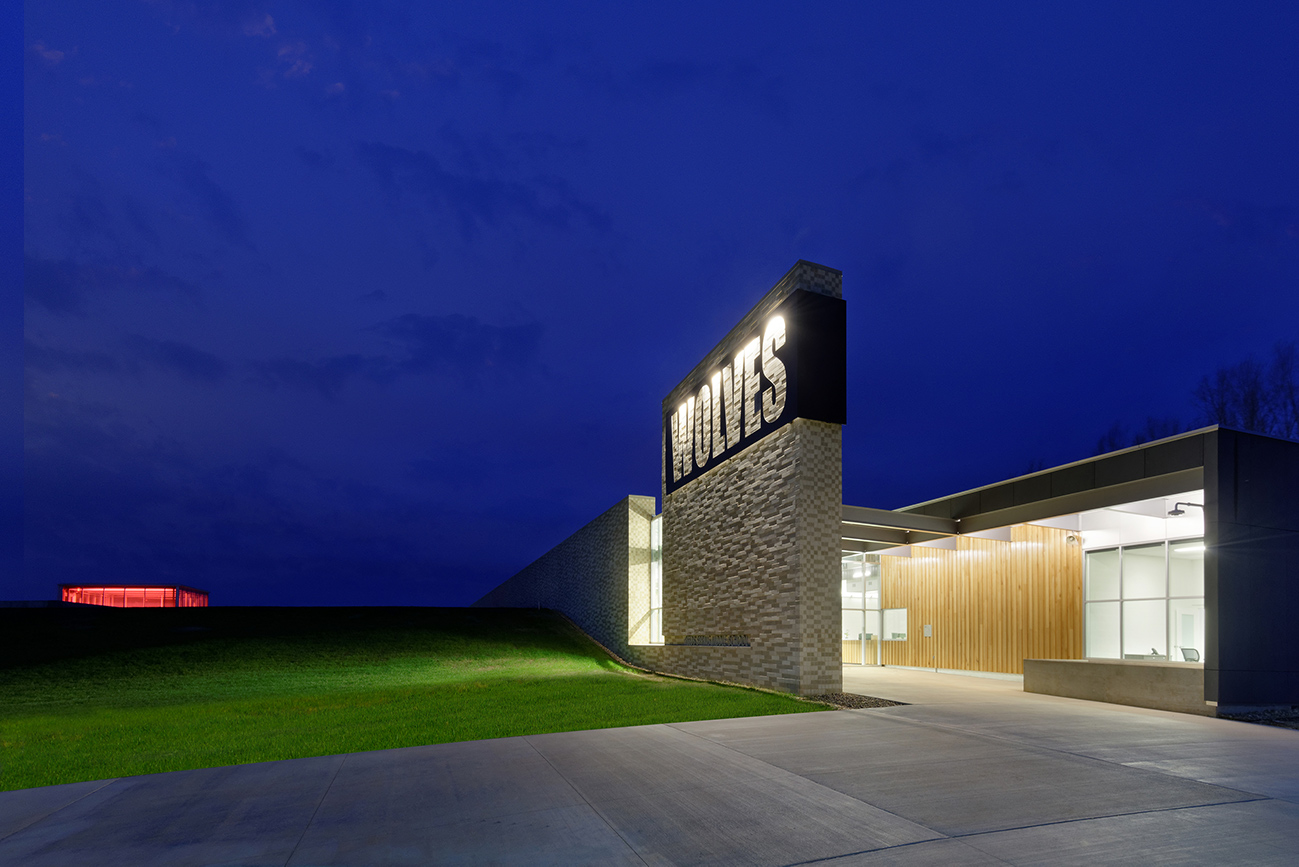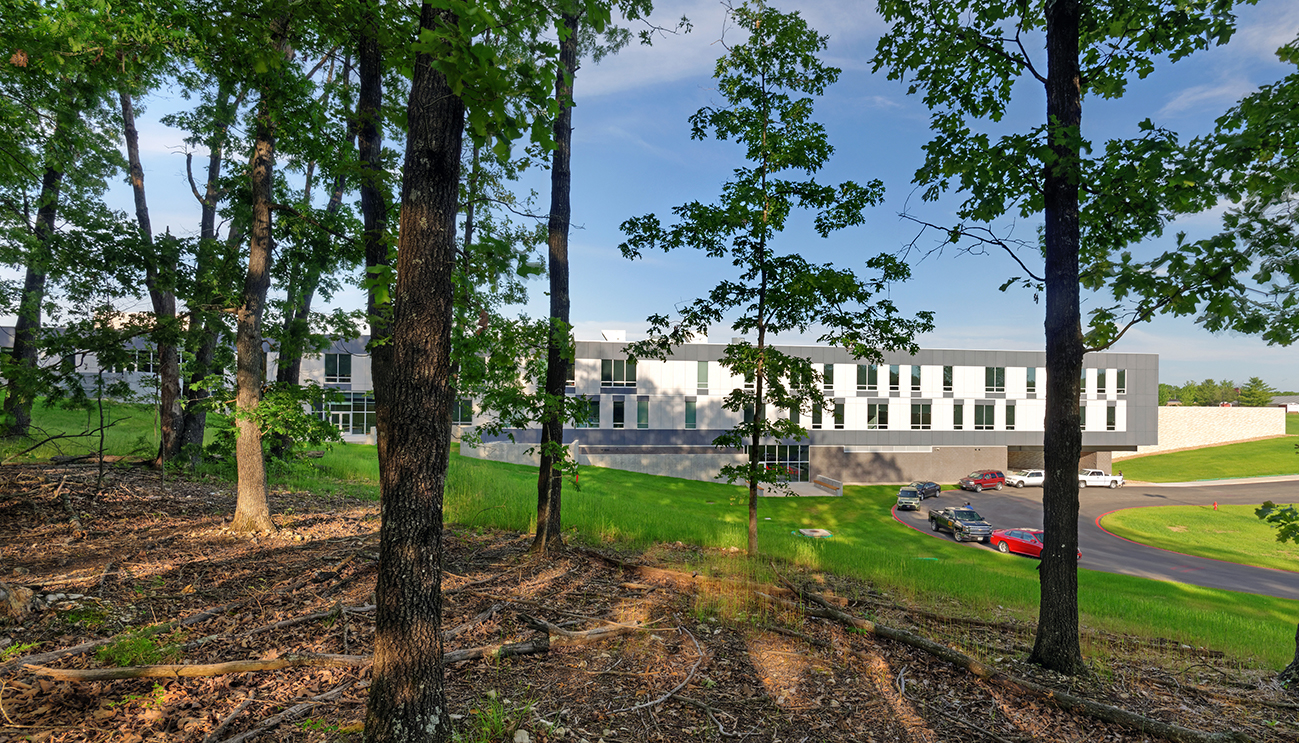For farmers-turned-architects Dake Wells, being green is second nature
Missouri designers Brandon Dake and Andrew Wells prioritize sustainability even when clients are less interested.
March 4, 2020

Green roof at the Reeds Spring Middle School in Reeds Spring, Missouri. Credit: Gayle Babcock, Architectural Imageworks, LLC
By Sarah Wesseler
Brandon Dake and Andrew Wells grew up on farms along Route 66 in rural Missouri. Their families tended large gardens and raised chickens, pigs, and cattle, but the food they produced “wasn’t for sale—it was to live off of,” Wells said. “I have such an appreciation for it now that I must admit I didn’t really have then. Digging through the dirt to pull potatoes out … that was hard work.”
Both men settled near their childhood homes after graduating from architecture school. Wanting to see more high-quality buildings in the region, they founded Springfield-based Dake Wells in 2004. (The firm has since opened a second office in Kansas City.)

The Sterling's Hillbilly sign, a Route 66 landmark near the Dake Wells founders' family farms. Credit: Dake Wells architecture
Thanks in part to the founders’ agrarian upbringing, environmental stewardship is an important aspect of the firm’s day-to-day practice. “People ask us about our sustainability philosophy, and it’s so ingrained that we have to really try to pull it out and separate it,” Dake said. “We just look at good design as being as sustainable as we can make it.”
The partners are quick to emphasize, however, that their projects aren’t on the cutting edge of green design—and that this would be, in some respects, a counterproductive goal. In a part of the country where topics like climate change and environmental regulation tend to be viewed with suspicion, the people and organizations that commission buildings—rural school districts and churches, for example—typically have little appetite for pushing the envelope on sustainability. And thanks to Missouri’s low energy costs, on-site photovoltaics and other renewable energy systems are a harder sell than they might be elsewhere.
To succeed in this context, the firm aims to make each of its projects as green as possible, regardless of whether the client asks them to prioritize sustainability as such. “If we bump up against something in a project where we get resistance, or can’t do all that we want to do, we don’t let that keep us from doing all that we can do,” Dake said.
To this end, the firm maximizes its use of low-tech, low-cost strategies like solar orientation, passive cooling, and adaptive reuse, while designing for long-term use. “We think a lot about, how are our buildings going to last for 100 years rather than 10 years?” said Wells. “What are the material choices so that they’re durable? How can we plan them so that they’re flexible and have a long life?”
Thoughtful client communication is another important tool. Instead of foregrounding sustainability when discussing design options, the firm works to understand what issues matter most to clients, then finds ways to address these goals through green strategies. For school boards concerned about budgets, for instance, Dake Wells may emphasize the cost savings associated with daylighting. “It is about just trying to learn what matters to our clients and responding to that,” said Wells. “But at the same time, we have our own thoughts about what makes really good work, and what makes responsible work.”
Their Reeds Spring Middle School project is an instructive example. “If we had said, ‘Hey, we want to do a sustainable building for you,’ they probably would have pushed back,” said Wells. “But what they said themselves is, ‘We want to preserve as many trees as we can; we want it to fit in the landscape. We’ve got to deal with stormwater runoff. There are tornados, they’re happening more and more often, so we need to be able to provide a safe place for our students and our faculty.’ All those things really drove that whole design approach without ever really calling it green architecture or sustainability. We just talked about it as being good design.”

Reeds Spring Middle School in Reeds Spring, Missouri. Credit: Gayle Babcock, Architectural Imageworks, LLC
The partners report that since the project opened, the school district has been happy that it not only addresses the original brief, but also brings unexpected benefits—reduced operational energy costs, for example, and increased physical activity and social interaction in the generous daylit atrium. As word has spread in the local community, other organizations have approached the firm to work on their buildings.
As the firm’s body of completed work grows, “it’s not just what the owner is saying; now it’s others recognizing that this work is different,” Dake said. “I think all of that helps our region increase its level of design and its emphasis on sustainability.”
Over the years, the partners have also pushed local consultants and contractors to improve their own green offerings, and have brought in outside experts as needed. “Our original goal was to raise the level of design work in our region, and we know that’s not just us doing it—it’s trying to challenge everybody to be better,” Wells said. “And I think we’re having some impact there.”
Dake Wells has also taken steps to share knowledge with like-minded firms around the country. In 2018, the firm’s sustainability director, Jason Hainline, reached out to the AIA Large Firm Roundtable to ask about joining the green design group. The response: Sorry, your firm’s too small. So Hainline joined forces with others at similarly sized offices and organized the first Small Firm Sustainability Roundtable at the 2019 national convention.
“Everybody’s got to be able to do their part,” Wells said. “And frankly, there are a lot more small firms in the country than there are large firms.”
Explore
Ants of the Prairie lecture
In her 2014 Emerging Voices lecture, Joyce Hwang advocates for cross-species design.
In conversation: Marlon Blackwell and Rick Joy
Blackwell and Joy reflect on first meeting 15 years ago, approaches to teaching, and a shared sensitivity to place while "transgressing the vernacular" in their work.
Duvall Decker Architects lecture
The founders of Mississippi-based Duvall Decker Architects discuss their work.


